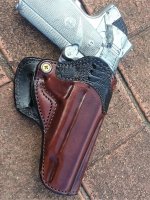Walkinghorse, the answers are good so far with the understanding that holsters are made from a vegetable tannage of the animal's two butt portions, called 'shell butt cordovan'. Much sought after for very expensive shoe uppers.
Horsehide bomber and motorcycle jackets would be made from a chrome tannage of the rest of the hide, to be supple, larger, and waterproof. You wouldn't want a jacket made out of little bits of veg tanned horsehide! Not least because it absorbs water. Which is why it was once used in holsters. There are only two tanners left in the world of veg horsehide, one in USA and one in Japan. One hears about modern horsehide production even today but it was made famous first by Chic Gaylord in the '50s and then by his protégé Paris Theodore in the '60s (who wasn't really in business more than about ten minutes; and I say that without disrespect because his designs are still a benchmark for style with function).
The other leathers are not used alone to make complete 'modern' (that is, stiff) holsters.
Kangaroo is a leather I use daily to line my cowhide holsters (notice where I live) and is super thin: 1mm or less despite the sheer size of the animal. The other leathers you mention are used as the outside of a cowhide holster; called a 'facing' vs. a lining. I would put all of them in the 'very wear resistant' category; but elephant is quite a thick leather. Another would be stingray: literally every surface of it is covered with beads of bone under a paper-thin layer of skin.
Another is ostrich, as a full hide or leg. An ostrich hide, used often in cowboy boots, is incredibly dear, as are all the others except kangaroo. But the leg is affordable if one wants only trim pieces and is the only part of the hide that has those striking scales extending from the claw to the knee. Very tear resistant as is kangaroo. I have used both in my work for years:

this one is in the 'avenger style' that John Bianchi and I created originally in the mid-1970s. It is much-advanced over the old one, in terms of design engineering, features, and material selection. Kangaroo inside, ostrich trim, American cowhide body.



